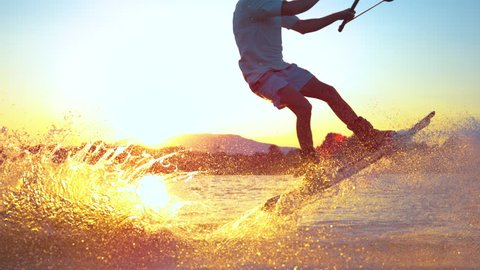
If you don’t have the luxury of living on a private lake or being near a cable park, odds are you are going to have to deal with rough water conditions from time to time. It can be pretty intimidating to get out on the wakeboard when the water is chopped up. In rough waters, it is harder to get air, land tricks, and even cut in and out of the wake. It also expels a lot more energy than when wakeboarding in calm waters. Here are some tips on how to go about wakeboarding in choppy waters.
3 Types of Chop
Lake water has primarily 3 types of chop: Wind, rollers, and combo chop. As you can imagine wind chop is created when there are higher than normal wind speeds on the lake. Rollers are waves created from other boats. These become a problem when the lake is crowded with heavy boat traffic. Lastly, There is combo chop. Combo chop is the unfortunate mixture of heavy winds and lots of boat traffic. This is the hardest kind of water to conquer.
Handling Wind Chop
Headwind
When the wind is blowing at your front, you are in a headwind. This causes you to go a bit slower which will make the tension in the rope greater. Many times in a headwind you will find it harder to clear the wake on your jumps because the line tension is greater while you’re in the air, and it is tougher to edge all the way through the wake on your cut. When facing a headwind, it is important to break your riding down to the fundamentals. Really focus on edging through the wake, and keeping the line tension strong while you are cutting so that the tension you experience in the air doesn’t whiplash you.
Tailwind
Any time the wind is at your back, you are experiencing a tailwind. Contrary to the headwind, this is going to make you move faster than you normally would. A tailwind typically makes the boat’s wake a bit flatter as well. When facing a tailwind, focus on really slowly building that progressive edge on your cuts so that you can keep your line tension. If you cut too fast, it will release the tension in the rope, which will then be compounded by the wind pushing you towards the boat. If the rope isn’t taut it is much harder to land tricks and jumps.
Crosswind
Crosswind is when the wind is coming at you from side to side. This wind is rather difficult to manage because it is going to effect you differently based on if you are cutting heelside or toeside. This is where you need to be very mindful and aware of how the wind is blowing. If cutting into the crosswind you will need to lean slightly harder into the cut. If cutting with the wind, you can edge more delicately and let the wind do some of the work as you hit the wake. With a crosswind you will just have to feel it out.
Rollers
Anybody wakeboarding on a public lake is almost always going to have to deal with rollers. However, in my opinion, rollers are much easier to deal with than wind chop. Rollers typically come in 2-3 wave bursts and are created from neighboring boats’ wakes. The good thing about these is that you can see them coming ahead of time, and they roll much smoother than wind chop. They are typically bigger than wind chop, but you can use that to your advantage. If you see rollers coming, you can go outside the wake, to the side they are coming from, and use them to get some air on an ollie. Also, when rollers hit your boat’s wake, the waves actually combine and make a bigger wake. So if you time it right, you can potentially create a bigger wake and a higher jump for yourself.

Riding with Chop
Its always going to be easier to ride on calm waters, but that is simply unrealistic to expect. When you have wind chop, rollers, or both, you’re always going to want to break your ride down into things you can control.
- Bend your knees more than normal and absorb the roughness with your legs.
- Keep great line tension by leaning against the line. Let the boat and the rope do the work of pulling you through the chop.
- Focus on keeping your edge all the way through the wake. Don’t let the rough waters scare you off from going big.
- Use the rollers to your advantage for ollies and bigger wake jumps, as stated in the paragraph above.
Don’t let sub-optimal water conditions discourage you from getting out on the wakeboard. You should be conquering the water, not the other way around.
Related Products
Hyperlite Indy CGA Wakeboard Vest
O’Neill’s Reactor Wakeboard Wetsuit
Related Articles
The 3 Fundamentals of Wakeboarding
Pingback:The Best Camera for Wakeboarding - Wakeboard Lifestyle